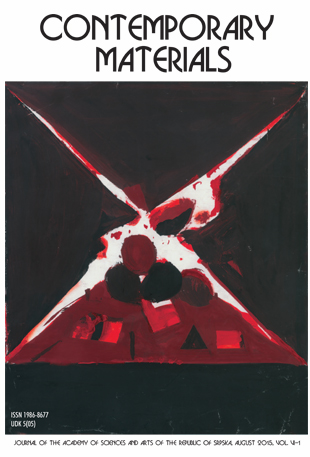CURRENT DISTRIBUTION DEPENDENCE ON ELECTRIC FIELD IN HELICALLY COILED CARBON NANOTUBES
DOI:
https://doi.org/10.7251/COMEN1702121PAbstract
Experimentally is confirmed that helically coiled carbon nanotube (HCCNT) could be used as a small solenoid for generating spatially localized magnetic field. Current distribution during diffusive electronic transport likewise the inductivity of this quantum conductor depends on electric field. Despite slightly lower electron mobility in HCCNTs than that of the straight single wall carbon nanotubes, the coiled nanotubes are attractive for application as nonlinear nano-solenoids. Nonequilibrium electron distribution functions obtained by solving Boltzmann transport equation are used to predict average helical radius of current flow as a function of electric field intensity. Change of spatial distribution of electronic flow with applied electric field is considered and nonlinear inductivity of HCCNT is predicted.
References
S. M. Avdoshenko, P. Koskinen, H.Sevinçli, A. A. Popov, C. G. Rocha, Topological Signatures in the Electronic Structure of Graphene Spirals, Scientific Reports, Vol. 3 (2013) 1632.
L. Zhao Liu, H. Li Gao, J. Jun Zhao, and J. Ping Lu, Superelasticity of Carbon Nanocoils from Atomistic Quantum Simulations, Nanoscale Res Lett., Vol. 5−3 (2010) 478–483.
H. M Faraby, A. M. Rao, P. R. Bandaru, Modeling High Energy Density Electrical Inductors Operating at THz Frequencies Based on Coiled Carbon Nanotubes, IEEE Electron Device Lett., Vol. 34−6 (2013).
K. Yamamoto, T. Hirayama, M.Kusunoki, S. Yang, S.Motojima, Electron holographic observation of micro-magnetic fieldscurrent-generated from single carbon coil, Ultramicroscopy, Vol. 106 (2006) 314–319.
Z. P. Popović, M. Damnjanović, I. Milo-šević, Phonon transport in helically coiled carbon nanotubes, Carbon, Vol. 77 (2014) 281–288.
I. Laszlo, A. Rassat, The geometric structure of deformed nanotubes and the topological coordinates, J. Chem. Inf. Comput. Sci., Vol. 43 (2003) 51924.
S. Dmitrović, Z. P. Popović, M. Damnjanović, I. Milošević, Structural model of semi-metallic carbon nanotubes, Phys. Status Solidi B, Vol. 250−12 (2013) 2627−2630.
V. Perebeinos, J. Tersoff, P. Avouris, Electron-phonon interaction and transport in semiconducting carbon nanotubes, Phys. Rev. Lett., Vol. 94 (2005) 086802.
G. Pennington, N. Goldsman, Semiclassical transport and phonon scattering of electrons in semiconducting carbon nanotubes, Phys. Rev. B, Vol. 68 (2003) 045426.
M. Damnjanović, I. Milošević, Full Symmetry Implementation in Condensed Matter and Molecular Physics Modified Group Projector Technique, Physics Reports, Vol. 581 (2015) 1−43.
D. Porezag, Th. Frauenheim, Th. Kohler, G. Seifert, R. Kaschner, Construction of tight-binding-like potentials on the basis of density-functional theory,Phys. Rev. B, Vol. 51 (1994) 12947.
D. W. Brenner, O. A. Shenderova, J. A. Harrison, S. J. Stuart,B. Ni, S. B. Sinnott, A second-generation reactive empirical bond order (REBO) potential energy expression for hydrocarbons, J. Phys. C, Vol. 14 (2002) 783.
J. Jiang, R. Saito, Ge. G. Samsonidze, S.G. Chou, A. Jorio, G. Dresselhaus, and M. S. Dresselhaus, Electron-phonon matrix elements in singlewall carbon nanotubes, Phys. Rev. B, Vol. 72 (2005) 235408.
I. Milošević, Z. P. Popović, M. Damnjanović, Structure and stability of coiled carbon nanotubes, Phys. Status Solidi B, Vol. 249 (2012) 2442−2445.
D. Querlioz, J. Saint-Martin, P. Dollfus, Implementation of the Wigner-Boltzmann transport equation within Particle Monte Carlo simulation, J. Comput.Electron, Vol. 9 (2010) 224–231.
T. Durkop, B. M. Kim, M. S. Fuhrer, Properties and applications of high-mobility semiconducting nanotubes, J. Phys.: Condens. Matter, Vol. 16 (2004) R553.
Z. P. Popović, T. Vuković, B. Nikolić, M. Damnjanović, I. Milošević, Prediction of elec-tron drift velocity in helically coiled carbon nanotubes, Contemporary Materials, Vol. VII−2 (2016) 116−120.
Z. P. Popović, T. Vuković, B. Nikolić, M. Damnjanović, I. Milošević, Transport in helically coiled carbon nanotubes: semiclassical aproach, Contemporary Materials, Vol. VI−1 (2015) 15−19.
M. Damnjanović, I. Milošević, T. Vuković, T. Marinković, Wigner-Eckart theorem in the inductive spaces and applications to optical transitions in nanotubes, J. Phys. A: Math. Gen., Vol. 37 (2004) 4059−4068.
K. Nakada, M. Fujita, G. Dresselhaus, M. S. Dresselhaus, Edge state in graphene ribbons: Nanometer size effect and edge shape dependence, Phys. Rev. B, Vol. 54, (1996) 17954.
M. Damnjanović, I. Milošević, Line Groups in Physics, Springer-Verlag, Berlin, 2010.
